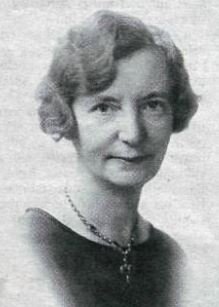An Ode to the Women of UI
Translation: Julie Summers
Kristínar Ólafsdóttir graduating class
In 1911, three individual post-secondary institutions for medicine, law, and theology merged, adding a philosophy department to form the University of Iceland. That same year, Parliament passed a law guaranteeing women the same right to education as men. Forty-five students were enrolled at the university its first year, including one woman. In the hundred-plus years that have since elapsed, that ratio has changed significantly. More and more women enrolled over the years, and they now make up a significant majority of the student body. But things didn’t change overnight.
The beginning: The first female student
Kristín Ólafsdóttir
The first female student I mentioned above was medical student Kristín Ólafsdóttir. In 1917, she also became the first woman to graduate from UI. Kristín was born in 1889 and became the third woman in Iceland to earn a diploma from the Latin School when she graduated in 1911. She’d had to study at home, as it was considered inappropriate for girls to learn alongside boys at the time. After graduating from UI, she traveled to Denmark and Norway with her husband, Vilmundur Jónsson, to continue her education. In 1931, Vilmundur was appointed Iceland’s Director of Health, and the couple, who had practiced medicine in Ísafjörður after returning from Scandinavia, moved to Reykjavík with their three children. In the city, Kristín opened her own medical practice, which she operated until the last few years of her life. She died in 1971 at the age of 81.
Kristín’s career is a noteworthy part of the university’s history. When you walk up the staircase in Aðalbygging toward the main hall on the second floor, you’ll find a portrait of Kristín that was presented to the school on its 100th anniversary in 2011 by the rector at the time, Kristín Ingólfsdóttir.
In the early decades, the attrition rate for female students was high. Women were not taken seriously as students, and in fact, many people thought that women who chose to study were just indulging a temporary hobby, biding time until marrying and setting up their homes. But over the course of the 20th century, the number of women dropping out decreased, and the number of female graduates increased slowly but surely. Women have made up the majority of graduating undergraduates since 1988 and the majority of graduating master’s students since 1998, with the exception of the year 2002. The change has been rapid – you might even say revolutionary. But what was Kristín’s legacy, and how did things progress?
Trailblazers
Björg Caritas Þorláksdóttir
The first Icelandic woman to complete a doctoral degree – and the first Nordic woman to earn such a degree from the Sorbonne – was Björg Caritas Þorláksdóttir, who graduated with a doctorate in psychology in 1926. But no woman completed a doctoral degree at UI until 34 years later, when Selma Jónsdóttir graduated with a doctorate of fine arts in 1960. Without a doubt, these women were trailblazers who paved the way for future generations of female students. On the home page of the Women’s History Archives, you can view a list of female doctoral graduates in Iceland, as well as their dissertation topics, from Björg to the year 2015. You’ll also find lists of other Icelandic women pioneers. I’ve selected just a few of the innumerable women who’ve left their mark on the UI community.
Selma Jónsdóttir
Anna Sigurðardóttir (1908-1996), founder and former director of the Women’s History Archives. In 1986, she became the first Icelandic woman to be awarded an honorary doctorate from the philosophy department.
Auður Auðuns (1911-1999), first Icelandic woman to graduate with a law degree (1935).
Ásta Dís Óladóttir (b. 1972) is the first Icelandic woman to serve as head of the business department of any Icelandic university. She was hired in 2009.
Dagný Kristjánsdóttir (b. 1949) defended her dissertation at UI in 1997. It was the first Icelandic-language dissertation at UI in the field of feminist studies.
Geirþrúður Hildur Bernhöft (1921-1987) was the first woman to graduate from UI with a theology degree. However, she was never ordained.
Helga Kress
Helga Kress (b. 1939) is the first woman who was appointed assistant professor in the philosophy department (1970). In 1997, she was appointed chair of the same department, becoming the first female department chair at the university.
Jóhanna Magnúsdóttir (1896-1981), pharmacist. In 1928, she became the first woman to earn her pharmacy license.
Karólína Sigríður Einarsdóttir (1912-1962) earned her teaching certificate in Icelandic studies from the university’s philosophy department in 1950, the first woman to do so.
Kristín Ingólfsdóttir (b. 1954), first female rector at UI, appointed in 2005.
Margrét Gumunda Guðnadóttir (1929-2018), virologist and first female professor at UI.
Sigríður Th. Erlendsdóttir (b. 1930), pioneering researcher who studied Icelandic women’s history. Became the first female honorary member of the Icelandic Historical Society in 2008.
Sigríður Þorgeirsdóttir (b. 1958), philosopher, hired as an assistant professor in philosophy at UI in 1997. First woman to earn a permanent position in the philosophy department.
Sigrún Helgadóttir (b. 1937) earned an undergraduate degree in engineering in 1963, the first woman to do so.
Steinunn Anna Bjarnadóttir (1897-1991) was the first woman to study Old Norse in the university’s philosophy department. She graduated in 1919.
Information taken from the Women’s History Archives website, kvennasogusafn.is.
Nokkrar staðreyndir
Í hundraðogníuára sögu Háskólans hefur einungis einn kvenkyns rektor verið settur í embættið.
Kristín Ingólfsdóttir var starfandi rektor á árunum 2005 til 2015, sú 38. til að gegna embættinu.Síðustu ár hefur kynjahlutfall nemenda við Háskóla verið um 2:1 konur. Þetta á við eins og staðan er núna.
Konur skipa formannssæti allra sviðsráða Háskólans að frátöldu Félagsvísindasviði þetta skólaárið.
Forseti Stúdentaráðs hefur verið kvenkyns síðustu fjögur árin í röð.
Sex af sjö starfsmönnum skrifstofu SHÍ eru konur.
Ritstjóri Stúdentablaðsins hefur verið kvenkyns fimm af síðustu sex árum.





